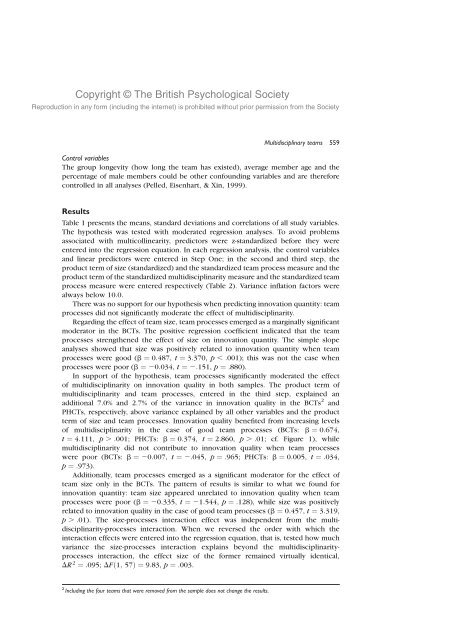Getting the most out of multidisciplinary teams: A multi-sample ... - IIMS
Getting the most out of multidisciplinary teams: A multi-sample ... - IIMS
Getting the most out of multidisciplinary teams: A multi-sample ... - IIMS
You also want an ePaper? Increase the reach of your titles
YUMPU automatically turns print PDFs into web optimized ePapers that Google loves.
Copyright © The British Psychological Society<br />
Reproduction in any form (including <strong>the</strong> internet) is prohibited with<strong>out</strong> prior permission from <strong>the</strong> Society<br />
Multidisciplinary <strong>teams</strong> 559<br />
Control variables<br />
The group longevity (how long <strong>the</strong> team has existed), average member age and <strong>the</strong><br />
percentage <strong>of</strong> male members could be o<strong>the</strong>r confounding variables and are <strong>the</strong>refore<br />
controlled in all analyses (Pelled, Eisenhart, & Xin, 1999).<br />
Results<br />
Table 1 presents <strong>the</strong> means, standard deviations and correlations <strong>of</strong> all study variables.<br />
The hypo<strong>the</strong>sis was tested with moderated regression analyses. To avoid problems<br />
associated with <strong>multi</strong>collinearity, predictors were z-standardized before <strong>the</strong>y were<br />
entered into <strong>the</strong> regression equation. In each regression analysis, <strong>the</strong> control variables<br />
and linear predictors were entered in Step One; in <strong>the</strong> second and third step, <strong>the</strong><br />
product term <strong>of</strong> size (standardized) and <strong>the</strong> standardized team process measure and <strong>the</strong><br />
product term <strong>of</strong> <strong>the</strong> standardized <strong>multi</strong>disciplinarity measure and <strong>the</strong> standardized team<br />
process measure were entered respectively (Table 2). Variance inflation factors were<br />
always below 10.0.<br />
There was no support for our hypo<strong>the</strong>sis when predicting innovation quantity: team<br />
processes did not significantly moderate <strong>the</strong> effect <strong>of</strong> <strong>multi</strong>disciplinarity.<br />
Regarding <strong>the</strong> effect <strong>of</strong> team size, team processes emerged as a marginally significant<br />
moderator in <strong>the</strong> BCTs. The positive regression coefficient indicated that <strong>the</strong> team<br />
processes streng<strong>the</strong>ned <strong>the</strong> effect <strong>of</strong> size on innovation quantity. The simple slope<br />
analyses showed that size was positively related to innovation quantity when team<br />
processes were good (b ¼ 0:487, t ¼ 3:370, p , :001); this was not <strong>the</strong> case when<br />
processes were poor (b ¼ 20:034, t ¼ 2:151, p ¼ :880).<br />
In support <strong>of</strong> <strong>the</strong> hypo<strong>the</strong>sis, team processes significantly moderated <strong>the</strong> effect<br />
<strong>of</strong> <strong>multi</strong>disciplinarity on innovation quality in both <strong>sample</strong>s. The product term <strong>of</strong><br />
<strong>multi</strong>disciplinarity and team processes, entered in <strong>the</strong> third step, explained an<br />
additional 7.0% and 2.7% <strong>of</strong> <strong>the</strong> variance in innovation quality in <strong>the</strong> BCTs 2 and<br />
PHCTs, respectively, above variance explained by all o<strong>the</strong>r variables and <strong>the</strong> product<br />
term <strong>of</strong> size and team processes. Innovation quality benefited from increasing levels<br />
<strong>of</strong> <strong>multi</strong>disciplinarity in <strong>the</strong> case <strong>of</strong> good team processes (BCTs: b ¼ 0:674,<br />
t ¼ 4:111, p . :001; PHCTs: b ¼ 0:374, t ¼ 2:860, p . :01; cf. Figure 1), while<br />
<strong>multi</strong>disciplinarity did not contribute to innovation quality when team processes<br />
were poor (BCTs: b ¼ 20:007, t ¼ 2:045, p ¼ :965; PHCTs: b ¼ 0:005, t ¼ :034,<br />
p ¼ :973).<br />
Additionally, team processes emerged as a significant moderator for <strong>the</strong> effect <strong>of</strong><br />
team size only in <strong>the</strong> BCTs. The pattern <strong>of</strong> results is similar to what we found for<br />
innovation quantity: team size appeared unrelated to innovation quality when team<br />
processes were poor (b ¼ 20:335, t ¼ 21:544, p ¼ :128), while size was positively<br />
related to innovation quality in <strong>the</strong> case <strong>of</strong> good team processes (b ¼ 0:457, t ¼ 3:319,<br />
p . :01). The size-processes interaction effect was independent from <strong>the</strong> <strong>multi</strong>disciplinarity-processes<br />
interaction. When we reversed <strong>the</strong> order with which <strong>the</strong><br />
interaction effects were entered into <strong>the</strong> regression equation, that is, tested how much<br />
variance <strong>the</strong> size-processes interaction explains beyond <strong>the</strong> <strong>multi</strong>disciplinarityprocesses<br />
interaction, <strong>the</strong> effect size <strong>of</strong> <strong>the</strong> former remained virtually identical,<br />
DR 2 ¼ :095; DFð1; 57Þ ¼9:83, p ¼ :003.<br />
2 Including <strong>the</strong> four <strong>teams</strong> that were removed from <strong>the</strong> <strong>sample</strong> does not change <strong>the</strong> results.










